Boost Your Health with Fiber: A Canadian Guide to Benefits, Foods & Daily Intake

Are you getting enough fiber in your diet? For Canadians, it's a common concern. Dietary fiber, often overlooked, is a nutritional powerhouse with incredible benefits for your digestive system, heart health, and even blood sugar control. But most of us aren't hitting the recommended daily intake. This guide breaks down everything you need to know about fiber – from different types and their unique advantages to delicious Canadian food sources and how to tailor your intake for optimal health.
Why is Fiber So Important for Canadians?
Canadians face unique health challenges, including a higher prevalence of certain chronic diseases. A fiber-rich diet can be a powerful tool in prevention and management. Here's why:
- Digestive Health: Fiber adds bulk to your stool, preventing constipation and promoting regularity. It also feeds beneficial gut bacteria, contributing to a healthy microbiome.
- Heart Health: Soluble fiber helps lower LDL (bad) cholesterol levels, reducing your risk of heart disease.
- Blood Sugar Control: Fiber slows down the absorption of sugar, helping to stabilize blood sugar levels and potentially reducing the risk of type 2 diabetes.
- Weight Management: Fiber promotes feelings of fullness, which can help you eat less and manage your weight.
Types of Fiber: Soluble vs. Insoluble
Not all fiber is created equal! There are two main types:
- Soluble Fiber: Dissolves in water, forming a gel-like substance. Found in oats, beans, lentils, apples, and citrus fruits. It's great for lowering cholesterol and stabilizing blood sugar.
- Insoluble Fiber: Doesn't dissolve in water and adds bulk to your stool. Found in whole wheat bread, brown rice, vegetables, and wheat bran. It's essential for digestive regularity.
A balanced diet should include both types of fiber.
Canadian Food Sources of Fiber: Delicious & Accessible
Luckily, Canada offers a wide variety of fiber-rich foods. Here are some easy ways to incorporate more fiber into your daily meals:
- Breakfast: Oatmeal with berries and nuts, whole-wheat toast with avocado.
- Lunch: Lentil soup, a hearty salad with beans and vegetables, a whole-wheat wrap with hummus and veggies.
- Dinner: Brown rice with roasted vegetables and lean protein, whole-wheat pasta with a vegetable-rich sauce, baked beans with whole-grain bread.
- Snacks: Apples, pears, carrots, air-popped popcorn, a handful of almonds.
How Much Fiber Do Canadians Need?
Health Canada recommends the following daily fiber intake:
- Women: 25 grams
- Men: 38 grams
Most Canadians only consume around 14-18 grams per day, highlighting the need for increased awareness and dietary changes.
Tips for Increasing Your Fiber Intake
- Read Food Labels: Pay attention to the fiber content listed on packaged foods.
- Gradually Increase Intake: Adding too much fiber too quickly can cause gas and bloating.
- Drink Plenty of Water: Fiber absorbs water, so staying hydrated is crucial.
- Choose Whole Grains: Opt for whole-wheat bread, brown rice, and quinoa over refined grains.
- Eat the Peel: Many fruits and vegetables have a good amount of fiber in their skin.






